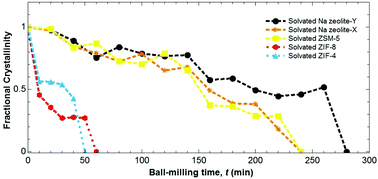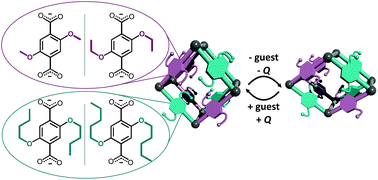Themed collection Flexibility and Disorder in Metal-Organic Frameworks

Flexibility and disorder in metal–organic frameworks
Welcome to this themed issue of Dalton Transactions entitled ‘Flexibility and Disorder in Metal–Organic Frameworks’.

Dalton Trans., 2016,45, 4058-4059
https://doi.org/10.1039/C6DT90026G
Defects and disorder in metal organic frameworks
The wide-ranging properties of metal organic frameworks (MOFs) rely in many cases on the presence of defects within their structures and the disorder that is inevitably associated with such defects.

Dalton Trans., 2016,45, 4113-4126
https://doi.org/10.1039/C5DT04392A
Flexible MOFs under stress: pressure and temperature
In the recent past an enormous number of Metal–Organic Framework type compounds (MOFs) have been synthesized.

Dalton Trans., 2016,45, 4100-4112
https://doi.org/10.1039/C5DT03228H
Origin of highly active metal–organic framework catalysts: defects? Defects!
This article provides a comprehensive review of the nature of catalytic sites in MOFs.

Dalton Trans., 2016,45, 4090-4099
https://doi.org/10.1039/C5DT03522H
Structural flexibility in crystallized matter: from history to applications
The large reversible flexibility of hybrid crystallized matter is relatively new.

Dalton Trans., 2016,45, 4073-4089
https://doi.org/10.1039/C5DT03547C
Neutral N-donor ligand based flexible metal–organic frameworks
This short review focuses on the flexibility aspect of MOFs based on neutral N-donor ligands with representative examples concerning the structural aspects and the subsequent properties induced by the reorganization of the frameworks.

Dalton Trans., 2016,45, 4060-4072
https://doi.org/10.1039/C5DT03443D
Adsorption deformation of microporous composites
We demonstrate a theoretical model to describe the behavior of flexible adsorbent materials, or soft porous crystals, when used in practical applications as nanostructured composites such as core–shell particles or mixed matrix membranes.

Dalton Trans., 2016,45, 4136-4140
https://doi.org/10.1039/C5DT03978A
Postsynthetic bromination of UiO-66 analogues: altering linker flexibility and mechanical compliance
Single-crystal to single-crystal post synthetic bromination of unsaturated carbon–carbon bonds in two related zirconium metal–organic frameworks leads to structures with lower elastic moduli.

Dalton Trans., 2016,45, 4132-4135
https://doi.org/10.1039/C5DT03178H
Freeze-drying synthesis of an amorphous Zn2+ complex and its transformation to a 2-D coordination framework in the solid state
An amorphous and metastable precursor for a Zn two-dimensional coordination framework was synthesised via freeze drying.

Dalton Trans., 2016,45, 4127-4131
https://doi.org/10.1039/C5DT03286E
Molecular separations with breathing metal–organic frameworks: modelling packed bed adsorbers
This work proposes a general strategy to model the adsorption behavior of phase changing metal–organic framework (MOF) adsorbents during column separations.

Dalton Trans., 2016,45, 4416-4430
https://doi.org/10.1039/C6DT00258G
Site-specific metal and ligand substitutions in a microporous Mn2+-based metal–organic framework
Mixed-ligand syntheses and post-synthetic metal exchange performed on the Mn3L3 structure type results in site-specific manipulations to the framework structure.

Dalton Trans., 2016,45, 4431-4438
https://doi.org/10.1039/C5DT05023E
Tuning the flexibility in MOFs by SBU functionalization
A new approach for the fine tuning of flexibility in MOFs, involving functionalization of the secondary building unit, is presented.

Dalton Trans., 2016,45, 4407-4415
https://doi.org/10.1039/C5DT03504J
Second harmonic generation microscopy reveals hidden polar organization in fluoride doped MIL-53(Fe)
Doping of MIL-53(Fe) with fluoride atoms introduces a polar organization in the structure when guest molecules are present.

Dalton Trans., 2016,45, 4401-4406
https://doi.org/10.1039/C5DT04632G
Assessment of the energetic performances of various ZIFs with SOD or RHO topology using high pressure water intrusion–extrusion experiments
The energetic performances of various ZIFs with SOD or RHO topology were evaluated by water intrusion–extrusion experiments under high pressure. The effects of the metal cation nature, the type of linker and the topology are discussed.

Dalton Trans., 2016,45, 4392-4400
https://doi.org/10.1039/C5DT03486H
Local structure of the metal–organic perovskite dimethylammonium manganese(II) formate
Total neutron scattering data suggest new geometries for transient hydrogen bonding in a disordered metal–organic framework.

Dalton Trans., 2016,45, 4380-4391
https://doi.org/10.1039/C5DT03687A
Flexibility in MOFs: do scalar and group-theoretical counting rules work?
Counting rules derived from mechanical engineering and rigidity theory are applied to MOFs. Scalar versions fail to predict flexibility, but group-theoretical variant succeed. The algorithm is presented in detail and two examples are solved step-by-step.

Dalton Trans., 2016,45, 4360-4369
https://doi.org/10.1039/C5DT03586D
Defects in metal–organic frameworks: a compromise between adsorption and stability?
Defect engineering has arisen as a promising approach to tune and optimise the adsorptive performance of metal–organic frameworks.

Dalton Trans., 2016,45, 4352-4359
https://doi.org/10.1039/C5DT04330A
Automated design of flexible linkers
This paper presents a method for the systematic and automated design of flexible organic linkers for construction of metal organic-frameworks (MOFs) in which flexibility, compliance, or other mechanically exotic properties originate at the linker level rather than from the framework kinematics.

Dalton Trans., 2016,45, 4338-4345
https://doi.org/10.1039/C5DT03511B
Coarse graining of force fields for metal–organic frameworks
We have adapted our genetic algorithm based optimization approach, originally developed to generate force field parameters from quantum mechanic reference data, to derive a first coarse grained force field for a MOF, taking the atomistic MOF-FF as a reference.

Dalton Trans., 2016,45, 4370-4379
https://doi.org/10.1039/C5DT03865K
Impact of mechanical deformation on guest diffusion in zeolitic imidazolate frameworks
The effect of the elastic strain modes of MOFs on the guest diffusivity was presented and analysed.

Dalton Trans., 2016,45, 4346-4351
https://doi.org/10.1039/C5DT03861H
Compositional control of pore geometry in multivariate metal–organic frameworks: an experimental and computational study
Changing the ratio of the dicarboxylates, L : L′, in MOFs of the general formula [Zn2(L)2–x(L′)x(dabco)] affords control of the pore geometry, through non-covalent interactions between the ligands.

Dalton Trans., 2016,45, 4316-4326
https://doi.org/10.1039/C5DT04045K
Crystal phase competition by addition of a second metal cation in solid solution metal–organic frameworks
Addition of small amounts of a second metal cation results in crystal phase competition during the synthesis of solid-solution MOFs.

Dalton Trans., 2016,45, 4327-4337
https://doi.org/10.1039/C5DT03856A
Understanding and solving disorder in the substitution pattern of amino functionalized MIL-47(V)
Electronic energies and elastic constants of four amino functionalized MIL-47(V) supercells were computed using the plane wave density functional theory to determine the influence of the substituent positions on the organic linker.

Dalton Trans., 2016,45, 4309-4315
https://doi.org/10.1039/C5DT03399C
High pressure behaviour and elastic properties of a dense inorganic–organic framework
The hydrostatic behaviour of a cubic dense inorganic–organic framework [DABCOH22+][K(ClO4)3] has been systematically studied via high-pressure synchrotron X-ray powder diffraction. Further first principles calculations of full elastic tensors give full mapping of the Young's moduli, shear moduli and Poisson's ratios of this material.

Dalton Trans., 2016,45, 4303-4308
https://doi.org/10.1039/C5DT03505H
Exploration of the mechanical behavior of metal organic frameworks UiO-66(Zr) and MIL-125(Ti) and their NH2 functionalized versions
The structural behaviour under mechanical stimuli of two metal organic frameworks, UiO-66(Zr) and MIL-125(Ti) and their amino-functionalized derivatives has been investigated by high-pressure powder X-ray diffraction up to 3.5 GPa.

Dalton Trans., 2016,45, 4283-4288
https://doi.org/10.1039/C5DT03621F
Molecular dynamics simulation study of various zeolitic imidazolate framework structures
We report the results of a series of molecular dynamics simulations on a number of zinc zeolitic imidazolate framework (ZIF) structures together with some lattice dynamics calculations on ZIF-4, providing information about the flexibilities of these structures.

Dalton Trans., 2016,45, 4289-4302
https://doi.org/10.1039/C5DT03508B
Synthesis and stabilization of a hypothetical porous framework based on a classic flexible metal carboxylate cluster
A hypothetical porous network isomeric to MIL-88/MIL-101 has been realized by the introduction of terminal ligands and further stabilized by crosslinking.

Dalton Trans., 2016,45, 4269-4273
https://doi.org/10.1039/C5DT03478G
A comparison of the amorphization of zeolitic imidazolate frameworks (ZIFs) and aluminosilicate zeolites by ball-milling
Amorphization of zeolitic imidazolate frameworks during ball-milling is much more rapid than that of aluminosilicate zeolites.

Dalton Trans., 2016,45, 4258-4268
https://doi.org/10.1039/C5DT03477A
Mixed-linker solid solutions of functionalized pillared-layer MOFs – adjusting structural flexibility, gas sorption, and thermal responsiveness
Structural flexibility in pillared-layer metal–organic frameworks can be controlled via the concept of mixed-linker solid solutions.

Dalton Trans., 2016,45, 4230-4241
https://doi.org/10.1039/C5DT03825A
A generalized adsorption-phase transition model to describe adsorption rates in flexible metal organic framework RPM3-Zn
The rate of adsorption to a flexible metal-organic framework is described via generalization of the Avrami theory of phase transition kinetics.

Dalton Trans., 2016,45, 4242-4257
https://doi.org/10.1039/C5DT03432A
Thermodynamics of the structural transition in metal–organic frameworks
A thermodynamic study of the structural large-pore (LP) to narrow pore (NP) transition in various Metal Organic Frameworks (MOFs) is presented.

Dalton Trans., 2016,45, 4274-4282
https://doi.org/10.1039/C5DT03591K
Understanding gate adsorption behaviour of CO2 on elastic layer-structured metal–organic framework-11
We demonstrate that CO2 gate adsorption behaviour of elastic layer-structured metal–organic framework-11 can be described by a thermodynamic model by free energy analysis with the aid of an adsorption experiment and a molecular simulation.

Dalton Trans., 2016,45, 4193-4202
https://doi.org/10.1039/C5DT03476K
Exact matrix treatment of an osmotic ensemble model of adsorption and pressure induced structural transitions in metal organic frameworks
Here we present an exactly treated quasi-one dimensional statistical mechanical osmotic ensemble model of pressure and adsorption induced breathing structural transformations of metal–organic frameworks (MOFs).

Dalton Trans., 2016,45, 4213-4217
https://doi.org/10.1039/C5DT03248B
The cation-dependent structural phase transition and dielectric response in a family of cyano-bridged perovskite-like coordination polymers
The cation-dependent phase transition and the relevant dielectric response were demonstrated in a family of cyano-bridged perovskite-like coordination polymers, [(CH3)nNH4−n]2[KFe(CN)6] (n = 1–4).

Dalton Trans., 2016,45, 4224-4229
https://doi.org/10.1039/C5DT03481G
Structure and properties of Al-MIL-53-ADP, a breathing MOF based on the aliphatic linker molecule adipic acid
A new breathing Al-MIL-53 framework incorporating adipic acid as linker molecules is reported and characterised in detail.

Dalton Trans., 2016,45, 4179-4186
https://doi.org/10.1039/C5DT03510D
The guest-dependent thermal response of the flexible MOF Zn2(BDC)2(DABCO)
The flexible MOF, Zn2(BDC)2(DABCO) presents unusual guest-dependent structural responses upon temperature changes.

Dalton Trans., 2016,45, 4187-4192
https://doi.org/10.1039/C5DT03710G
Encapsulation of dyes in metal–organic frameworks and their tunable nonlinear optical properties
Two series of cationic dyes have been encapsulated in the 1D channel of MOFs, and the tunable second order nonlinear optical properties of these MOF⊃dye materials were observed.

Dalton Trans., 2016,45, 4218-4223
https://doi.org/10.1039/C5DT03466C
Molecular simulation of low temperature argon adsorption in several models of IRMOF-1 with defects and structural disorder
Low temperature adsorption of argon in several conceptual models of IRMOF-1 featuring various types of defects and inclusions has been investigated.

Dalton Trans., 2016,45, 4203-4212
https://doi.org/10.1039/C5DT03498A
Compositional dependence of anomalous thermal expansion in perovskite-like ABX3 formates
Thermal expansion in ABX3 formates is correlated to the size and molecular anisotropy of the A- and B-site cations.

Dalton Trans., 2016,45, 4169-4178
https://doi.org/10.1039/C5DT03263F
The flexibility of modified-linker MIL-53 materials
The flexibility of eight aluminium hydroxo terephthalates [Al(OH)(BDC–X)] (X = –H, –CH3, –Cl, –Br, –NH2, –NO2, –(OH)2, –CO2H) has been investigated upon thermal dehydration, superhydration and methanol adsorption/desorption using in situ powder X-ray diffraction.

Dalton Trans., 2016,45, 4162-4168
https://doi.org/10.1039/C5DT03438H
Explaining the mechanical mechanisms of zeolitic metal–organic frameworks: revealing auxeticity and anomalous elasticity
The detailed mechanical characteristics of four structurally polymorphic ZIFs have been computed using density functional theory. We elucidate the anomalous elastic behaviour ranging from zero Poisson's ratio and auxeticity, to negative linear compressibility and a remarkably low resistance to shear deformation.

Dalton Trans., 2016,45, 4154-4161
https://doi.org/10.1039/C5DT03514G
High volumetric uptake of ammonia using Cu-MOF-74/Cu-CPO-27
The MOF Cu-MOF-74/Cu-CPO-27 was identified as a candidate for high-volumetric ammonia uptake due to the high density of Cu sites.

Dalton Trans., 2016,45, 4150-4153
https://doi.org/10.1039/C5DT03436A
Elucidating the mechanism responsible for anomalous thermal expansion in a metal–organic framework
A mechanistic model is developed to reproduce concerted changes in the internal coordinates of the coordination helix of a MOF and evaluated using DFT.

Dalton Trans., 2016,45, 4141-4149
https://doi.org/10.1039/C5DT01927C
About this collection
Guest edited by: Professor Anthony Cheetham FRS, Professor Alain Fuchs FRSC, Dr Thomas Bennett and Dr François-Xavier Coudert.
This themed issue focuses on the experimental characterization, fundamental understanding and computational modelling of the flexibility and/or disorder of metal–organic frameworks (MOFs), and other inorganic framework-type materials. It also encompasses the consequences of this flexibility for the proposed applications of MOFs, and the associated possibilities to leverage these properties to design novel materials with targeted properties.